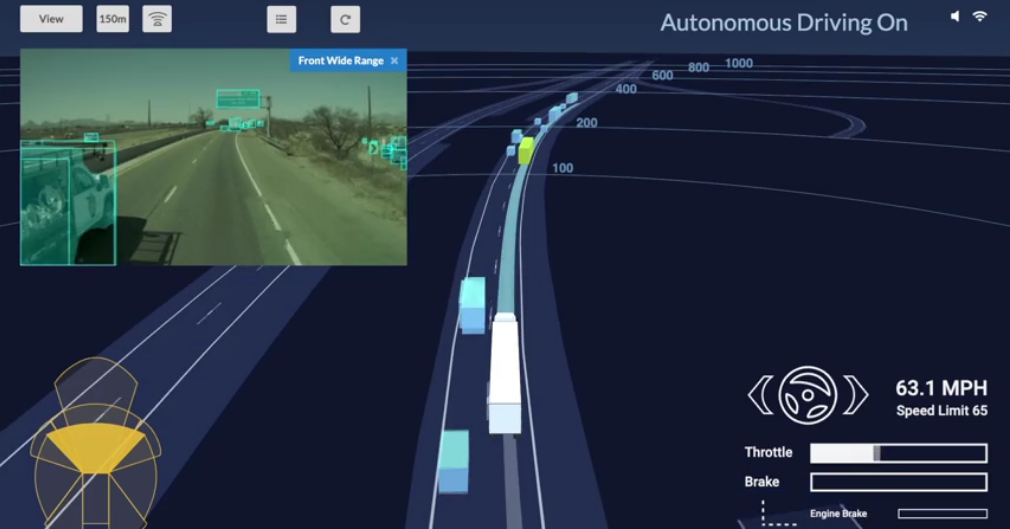(NewsNation) — Many Americans might not realize that driverless tractor-trailers are currently navigating the nation’s highways, hitting the open road with absolutely nobody behind the wheel.
Many of us have ridden in a smaller car — like a Tesla — that has a driverless feature, but to be in a large freight truck that is maneuvering through cities and highways is a completely different ballgame.
It’s the future of the industry, but the future is already here.
Autonomous driving technology company TuSimple was founded in San Diego in 2015 with a mission to improve the safety and efficiency of the trucking industry.
TuSimple is a developer of heavy-duty, self-driving trucks and the autonomous startup has already created a freight network along the Sun Belt from Phoenix to Houston.
“This is better, no doubt about it,” said Jim Mullen, chief administrator and legal officer for TuSimple. “That’s not a slight on the human driver whatsoever, it’s just factual.”
TuSimple’s driverless truck is built to blend in, but equipped with high-definition cameras, radars and artificial intelligence. It can “see” a thousand meters ahead and 360 degrees around the vehicle.
According to Mullen, it’s far more aware and advanced than human detection.
“It doesn’t get mad, there’s no road rage, it’s in no hurry,” Mellen said. “It doesn’t have the characteristics that we as humans sometimes have.”
But seeing it and experiencing it are two different things.
NewsNation correspondent Markie Martin recently traveled to Tucson, Arizona inside one of the autonomous trucks.
Martin and her crew hopped inside a driverless semi and rode along for an hour as it drove itself across an Arizona highway.

“Autonomous driving started,” the system chimed as it took the helm during their test ride.
While in autonomous mode, the truck is driving itself.
Koabi Brooks, TuSimple’s general manager, has been working on the company’s “driver-out” system for four years and no longer gets nervous when taking his hands off the wheel.
The “driver-out” system drove for an hour up and down the Arizona highway, switching lanes, taking exit ramps and maneuvering around traffic — all while nobody touched the wheel.
“The technology’s here … we have to show the world that it works,” Brooks said. “And really, for over-the-road trucking, we do think that ‘driver-out’ is the next step for this. When people talk about the driver shortage, they’re really talking about over the road. There are plenty of drivers out there, but living on the road … is less and less popular.”
NewsNation also spoke to David Gaber, product manager with Waymo Via, an autonomous trucking company, about the safety precautions of driverless trucking.
“We take safety very seriously,” Gaber said during a Thursday appearance on “NewsNation Prime.” “We have a rigorous safety framework that we published. It’s available at waymo.com. That framework contains both methodologies and principles and plans for testing our technology both on closed course as well as simulation.
“We think this technology is most appropriate for long-haul, over the road routes, today. These are the same routes that truck companies have a very hard time recruiting for. We want to deploy this technology on routes that are hundreds if not thousands of miles, because these are the routes where truck drivers have to spend days, or weeks, away from friends and family.
“Our trucks do not get lonely, they do not get bored, they do not miss home. And so we see this technology as a natural compliment to serve these ultra long-haul routes. And that would allow existing trucking fleets to focus on regional routes, with the added benefit of truckers getting … to go home every month,” Gaber added.
The driver shortage is a real issue facing the industry. It’s projected by the American Trucking Associations (ATA) that the shortage will surpass 160,000 positions by 2030.
TuSimple says the company is trying to help solve for that, not push truckers out of a job.
“If you’re a truck driver today or even thinking about being a truck driver, you will continue to have a full career as a truck driver,” Mullen said.
And the benefits of driverless freight are numerous — as it not only reduces fuel consumption and carbon emissions but also works to alleviate supply chain delays.
Mullen uses the specific example of getting fresh produce from Arizona to Oklahoma, saying, “We were able to get those watermelons from Nogales to Oklahoma City in 14 hours. If you did that with a human driver, that’s about a 24-hour run.”
Providing the consumer with fresher produce and everyday deliveries at a faster rate is the company’s focus.
So far, TuSimple has completed hundreds of miles of autonomous deliveries in Arizona and plans to start commercializing in 2024.
It’s a date when everyday drivers can expect to frequently share the nation’s highways with semitrailers without a driver at the wheel.
